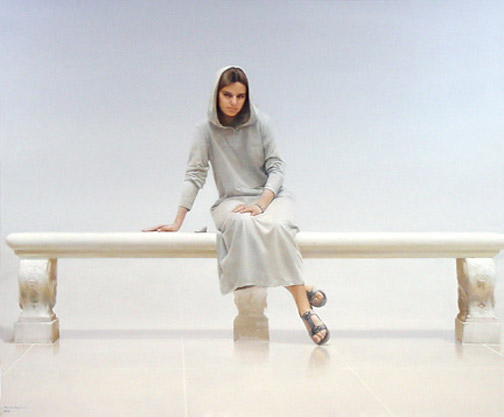 |
 |
Le Louvre
oil on canvas, 60" x 72", 153cm. x 183cm.
exhibited at Salon D'Automne, annual international art show, Paris France
In 2000 Pogrebinsky visited Paris, where he was inspired by the magnificent marble courtyards of the Louvre Museum. The Marley Courtyard of the Louvre, in which Pogrebinsky took photographs in the preparation of the work, shines with warm soft marble and old exquisite sculptures of the renaissance. Bringing back with him the inspiration of the light and color of the Louvre, Pogrebinsky began working on the painting later next year. After the first show in Paris Pogrebinsky thought that the painting was not fully finished to his satisfaction and he continued to work on the painting. It’s almost ascetic in its essence – a young woman sits calmly on a marble bench that sits upon a marble floor. But it is always difficult to arrive to such simplicity. This is a mark of a work of great art that we see such simplicity come through the luminous array of light – as if the world is drenched in light, and things are not created out of solid material objects, but it is a beautiful idea created out of the light.
In purely technical terms there is no doubt over the artist’s mastery of the work. The cloth, the small shadows, the reflective nature of the floor, the delicacy of the sandals, and the overall harmony with which the work is presented is truly phenomenal. The brush strokes are so unnoticed that many will take the clarity of the work as some production by other, perhaps more advanced means. But the closer the observer comes to study the actual lines of the brushes, and the tones used, does one understand with what quality and patience Le Louvre has been composed.
Everything in the painting is done in a realistic manner but in such a technique which takes you away from purely materialistic perception. The mind and the spirit come to play the main role.
The light, which is probably the main structure in the painting, weaves and
permeates all the objects and details in the canvas.
You already can perceive the marble floor but it is still in a transitional stage and will never become fully materialized because the light density has already reached its potential in the main goal: a young person, beautiful lady and her support the marble bench came to existence in a soft and distinctively visible form.
Nothing more, no unnecessary casual, random details, nothing more is needed to add to the concept of the painting. In such seemingly simple way the beauty came to the light as a manifestation of the divine spirit.
It’s isn’t by accident that
Pogrebinsky gave it such an obvious name. The Louvre stands in the center of
Europe, in one of the most intellectual and artistic centers of the world.
Since the late sixteenth century the Louvre had already been noticed as a
supreme collector of beautiful and mystical world art. By the late eighteenth
century it, already, collected some of the only works of the greatest Dutch and
Flemish artists, as well as broad collections of Renaissance painting, Greek
sculpture, and Egyptian art. Since 1848, though, the Louvre became a public
museum and breathtaking leaps into the world of thought and emotion where open
to everyone. Thus, over the nineteenth and twentieth centuries, as it expanded
and grew, the Louvre became a collection of more then just human creation – it
became the collection of human
creative spirit, the artistic spirit of all
humanity throughout the ages. Le Louvre isn’t merely the name of a
great painting – it is a symbol for what humanity is most capable of.
Le Louvre is perhaps one of those rare works that leap over the foundations on what was once a style and stands as a symbol of something new and timeless. It isn’t exceptional merely as a pure example of impeccable technique, an abandonment of post-modern arrangement, and the total embrace of a new kind of visual harmony – but it also stands as a new change in the course of artistic style in the Western world, as a prime example of the forces of Philosophical Realism; the harmony of style and colors, minimalism of material, and the focus on the infinite complexity of light and color.